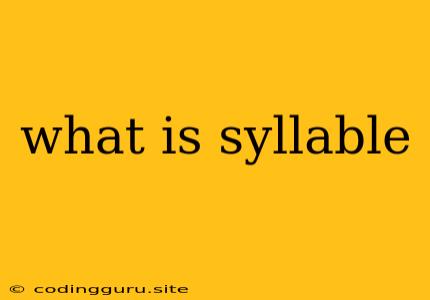What is a Syllable?
Have you ever wondered what makes words sound the way they do? Why is "cat" a short word, while "elephant" feels much longer? The answer lies in syllables.
A syllable is the basic unit of pronunciation in a word. It's a single, uninterrupted sound made up of one vowel sound and any surrounding consonants. Every word is made up of one or more syllables.
Let's break it down further.
How to Identify Syllables
- Vowel Sound: The heart of a syllable is the vowel sound. It's the sound you make with your mouth open, like "a" in "cat" or "i" in "kite."
- Consonants: Consonants are sounds you make by blocking the flow of air, like "b" in "ball" or "t" in "tree." They can come before or after the vowel sound within a syllable.
Counting Syllables
To count syllables in a word, follow these simple steps:
- Say the word out loud.
- Listen for each separate vowel sound. Each vowel sound generally corresponds to one syllable.
- Count the vowel sounds you hear.
For example:
- Cat: One vowel sound ("a"), so one syllable.
- Elephant: Two vowel sounds ("e" and "a"), so two syllables.
- Butterfly: Three vowel sounds ("u," "i," and "y"), so three syllables.
Why Syllables Matter
Understanding syllables is important for:
- Pronunciation: Syllables help us break down words and pronounce them correctly.
- Spelling: Recognizing syllable patterns helps us spell words accurately.
- Reading: Being aware of syllables improves reading fluency and comprehension.
Tips for Recognizing Syllables
- Look for vowel letters: Vowel letters (a, e, i, o, u, and sometimes y) are often the key to identifying syllables.
- Listen for vowel sounds: Focus on how the word sounds rather than just looking at the letters.
- Practice: The more you practice identifying syllables, the easier it becomes.
Examples of Syllable Patterns
Here are some common syllable patterns in English:
- Closed Syllable: A syllable that ends with a consonant, like "cat," "dog," and "sun."
- Open Syllable: A syllable that ends with a vowel, like "go," "me," and "by."
- Vowel Digraph Syllable: A syllable that contains two vowels together, like "eat," "rain," and "boat."
Conclusion
Understanding syllables is essential for mastering language skills. It helps us pronounce words correctly, spell them accurately, and read with fluency. By learning to recognize and count syllables, we can enhance our understanding of the building blocks of language.
